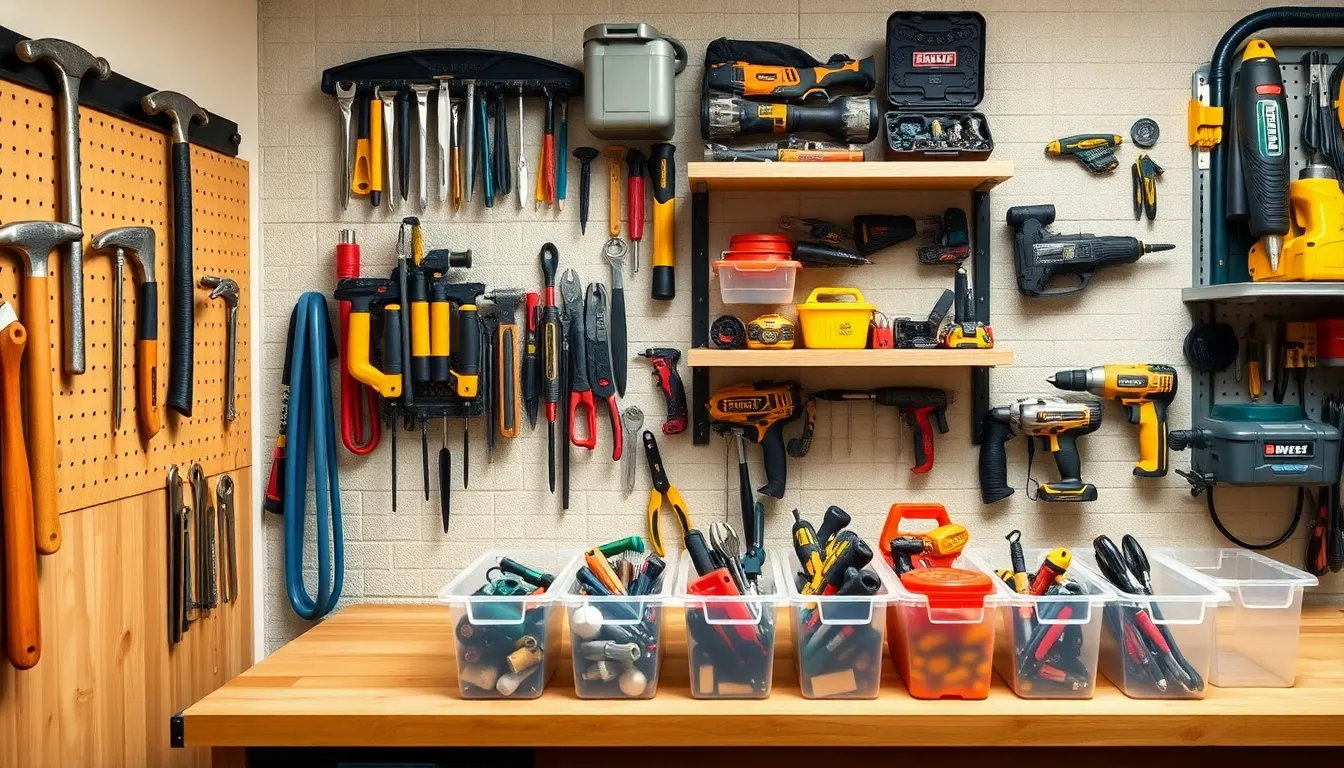A cluttered workshop can feel like a scene from a horror movie—tools lurking in every corner, just waiting to trip you up. But fear not! Organizing tools doesn’t have to be a daunting task. With a bit of creativity and some clever strategies, he can transform that chaotic space into a well-oiled machine.
Imagine walking into a workshop where each tool has its own designated spot, and finding what you need feels like a walk in the park. Not only does this save time but it also keeps frustrations at bay. Plus, who wouldn’t want to impress friends with a workspace that screams “I’ve got my life together”? Let’s dive into the art of tool organization and turn that tool jungle into a sanctuary of efficiency.
Table of Contents
ToggleImportance Of Organizing Tools In Workshop
Organizing tools in a workshop carries significant benefits that enhance productivity and efficiency. A clutter-free environment not only saves time but also reduces the frustration associated with searching for misplaced tools. Creating a systematic layout allows for quick access to frequently used items, streamlining work processes.
Managing tools effectively also contributes to safety. When tools remain organized, there’s less risk of accidents caused by tripping or grabbing the wrong tool. Improved safety standards promote a more comfortable workspace and encourage extended periods of activity.
Maintaining an organized workshop impresses peers and potential clients. A tidy environment reflects professionalism and attention to detail, enhancing credibility. He or she who presents an orderly workspace often gains admiration and respect.
Tool longevity benefits from proper organization. Storing tools correctly prevents wear and tear, ensuring they perform optimally over the years. Regular maintenance becomes easier when tools are easy to locate, prolonging their usability.
Establishing a routine for organizing tools fosters discipline. Habitual practices, such as returning tools to their designated spots, lead to consistent organization. Discipline in this area transforms a chaotic workshop into an efficient haven.
Tracking inventory of tools remains easier in an organized setting. Knowing what’s available helps avoid unnecessary purchases and ensures the right tools are on hand for any task. Awareness that comes from organization supports smarter decision-making regarding tool usage and procurement.
Overall, the importance of organizing tools in a workshop extends beyond aesthetics. Effectively managing tools enhances productivity, ensures safety, impresses visitors, prolongs tool life, promotes discipline, and facilitates inventory management.
Types Of Tools To Organize

Organizing tools involves categorizing various types based on usage and function. Understanding these categories enhances efficiency and simplifies storage solutions.
Hand Tools
Hand tools include essential items like hammers, screwdrivers, and pliers. These tools often require easy access for frequent use. Storing them in wall-mounted racks or toolboxes increases visibility and reduces clutter. Grouping similar hand tools together saves time during projects. Labels on drawers or shelves help identify tools quickly, maintaining an orderly workspace.
Power Tools
Power tools consist of drills, saws, and routers, all demanding proper storage. Heavy-duty cases or dedicated shelving units protect these valuable assets and enhance safety. Keeping cords organized with cable ties prevents tangling and damage. Identifying unused power tools for donation can free up space and promote an efficient environment. A clearly marked storage area for power tools ensures ease of access, minimizing distractions.
Miscellaneous Tools
Miscellaneous tools range from measuring tape to clamps, often overlooked during organization. Storing these items in a labeled bin or drawer prevents confusion in the workspace. Utilizing clear containers makes it easier to see contents and quickly retrieve desired tools. Creating a designated space for this category centralizes tool management and promotes productivity. Regularly reviewing this collection helps eliminate unused items, ensuring an efficient workshop environment.
Organization Methods
Effective organization methods facilitate a clutter-free workshop environment. Implementing shelving units, tool cabinets, and pegboards enhances efficiency and accessibility.
Shelving Units
Shelving units provide ample space for storing larger tools and equipment. Metal or wood designs support weight while maintaining durability. Positioning shelves at eye level ensures frequent items remain visible. Labeling shelves assists with quick identification. Additionally, using adjustable shelves accommodates multiple tool sizes, allowing for versatile organization.
Tool Cabinets
Tool cabinets promote secure storage for valuable hand and power tools. Lockable cabinets increase safety while preventing unauthorized access. Arranging tools in designated drawers streamlines the retrieval process, keeping everything in its place. Drawer organizers maximize space, offering dedicated spots for smaller items. Regularly cleaning cabinets maintains organization, ensuring tools remain easy to access.
Pegboards
Pegboards maximize wall space for tool storage, transforming vertical areas into accessible tool zones. Hooks and bins on pegboards allow for customized layouts suited for specific tools. By hanging tools in plain sight, users save time searching, which boosts productivity. Mixing pegboard accessories adds versatility, accommodating various tool types. Regularly updating pegboard arrangements enhances functionality based on user needs.
Tips For Maintaining Organization
Maintaining organization in a workshop, while crucial, can be straightforward. Regularly cleaning the workspace helps keep tools in their designated places, making it easier to find what’s needed. Set aside time each week for cleaning and organizing. Dust and debris can accumulate quickly, impacting safety and efficiency. Create a habit of returning each tool to its spot after use, preventing clutter from building up.
Categorization is key for efficient tool management. Separate tools by type and frequency of use. Hand tools might reside in easily accessible drawers, while power tools could be stored in a locked cabinet to prevent unauthorized access. Miscellaneous items should also have their space; use labeled bins to avoid confusion. Establishing a clear categorization system enhances workflow, making it easy to locate the right tool without wasting time.
Maintaining an accurate tool inventory is essential for workshop efficiency. Regularly update your list of tools and supplies to track what’s available and what’s needed. Investing time in inventory management prevents unnecessary purchases and ensures all tools are accounted for. Consider using a simple spreadsheet or tool-tracking app to streamline this process. By keeping an up-to-date inventory, productivity increases, and the risk of tool loss decreases significantly.
Organizing a workshop is more than just tidying up; it’s about creating a functional space that enhances productivity and safety. By implementing effective strategies and maintaining a routine, anyone can transform a cluttered area into an efficient workspace.
The right storage solutions not only protect tools but also make them easily accessible. Regularly reviewing and updating organization methods ensures that the workshop continues to meet evolving needs.
Ultimately, a well-organized workshop reflects professionalism and fosters a sense of pride in one’s work. With these principles in mind, achieving a clutter-free environment is within reach, paving the way for greater creativity and efficiency.


